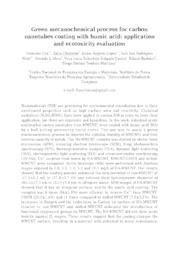Green mecanochemical process for carbon nanotubes coating with humic acid: application and ecotoxicity evaluation.
Green mecanochemical process for carbon nanotubes coating with humic acid: application and ecotoxicity evaluation.
Author(s): COA, F.; CLEMENTE, Z.; LOPES, J. R.; RODRIGUES NETO, L. L.; ALVES, O. L.; CASTRO, V. L. S. S. de; BARBIERI, E.; MARTINEZ, D. S. T.
Summary: Nanomaterials (NM) are promising for environmental remediation due to their unreleased properties such as high surface area and reactivity. Chemical oxidations (H2SO4/HNO3) have been applied to carbon NM in order to favor their application, but these are expensive and hazardous. In this work, industrial grade multiwalled carbon nanotubes (raw-MWCNT) were coated with humic acid (HA) by a ball milling processing (solid state). The aim was to apply a green mechanochemical process to improve the colloidal stability of MWCNTs and their removal capacity of metals. The HA-MWCNT complex was studied by atomic force microscope (AFM), scanning electron microscope (SEM), X-ray photoelectron spectroscopy (XPS), thermogravimetric analysis (TGA), dynamic light scattering (DLS), electrophoretic light scattering (ELS) and ultraviolet-visible spectroscopy (UV-Vis). Cu2+ sorption from water by HA-MWCNT, MWCNT-COOH and milledMWCNT were compared. Acute bioassays (96h) were performed with Daphnia magna exposed to 0.0; 0.1; 1.0; 5.0 and 10.0 mg/L of HA-MWCNT. Our results showed that the coating process enhanced the zeta potential of raw-MWCNT of -25.4±0.2 mV to -37.4±0.7 mV and reduced their hydrodynamic diameter of 393.2±27.3 nm to 212.5±5.6 nm in ultrapure water. AFM images of HA-MWCNT showed that it has an irregular surface, due to the humic acid coating. The complex was 4 times (84±1.8%) more efficient to remove Cu2+ than MWCNTCOOH (20.0±1.4%) and 11 times compared to milled-MWCNT (7.6±3.1%). The increases in Oxygen and the reductions in Carbon on surface of HA-MWCNT relative to raw-MWCNT and milled-MWCNT indicated the introduction of functional oxygenated groups on MWCNT. The HA-MWCNT did not show acute toxicity against D. magna. These results suggest that the coating changes the MWCNT surface, resulting in a material with potential to metal remediation, prepared without oxidizing acids and that did not show toxicity on D. magna.
Publication year: 2016
Types of publication: Abstract in annals or event proceedings
Unit: Embrapa Environment
Keywords: Ecotoxicologia, Nantubes
Observation
Some of Embrapa's publications are published as ePub files. To read them, use or download one of the following free software options to your computer or mobile device. Android: Google Play Books; IOS: iBooks; Windows and Linux: Calibre.
Access other publications
Access the Agricultural Research Database (BDPA) to consult Embrapa's full library collection and records.
Visit Embrapa Bookstore to purchase books and other publications sold by Embrapa.

